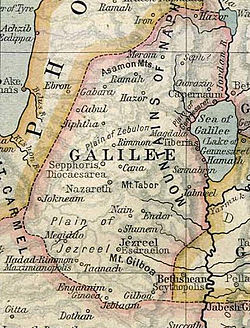คานา

คานาแห่งกาลิลี (อังกฤษ: Cana of Galilee; กรีกโบราณ: Κανὰ τῆς Γαλιλαίας; อาหรับ: قانا الجليل, อักษรโรมัน: Qana al-Jalil, แปลตรงตัว 'Qana of the Galilee') เป็นสถานที่ที่จัดงานสมรสที่หมู่บ้านคานา ที่ซึ่งมีการอัศจรรย์เปลี่ยนน้ำให้เป็นเหล้าองุ่นตามที่บรรยายในพระวรสารนักบุญยอห์น
ตำแหน่งที่ตั้งของคานายังเป็นที่ถกเถียง โดยมีสถานที่หลัก 4 แห่ง ได้แก่ Kafr Kanna, Khirbet Qana และ Reineh ในกาลีลีล่าง และ Qana ในกาลิลีบนในเลบานอน กล่าวกันว่าชื่อภาษาอาหรับ "Qana al-Jalil" ใช้เรียกสถานที่หลายแห่ง[1] ชื่อคานาอาจมาจากคำในภาษาฮีบรูหรือภาษาแอราเมอิกที่มีความหมายว่าต้นกก[2]
งานเขียนที่อ้างอิงถึงคานา
[แก้]การอ้างอิงในคัมภีร์ไบเบิล
[แก้]
ในหมู่คริสต์ศาสนิกชนและผู้ศึกษาพันธสัญญาใหม่คนอื่น ๆ คานาเป็นที่รู้จักในฐานะสถานที่ที่พระเยซูทรงแสดง "หมายสำคัญแรก" ตามที่บรรยายในพระวรสารนักบุญยอห์น การอัศจรรย์ต่อสาธารณชนครั้งแรกของพระองค์คือการทรงเปลี่ยนน้ำปริมาณมากให้เป็นเหล้าองุ่นในงานสมรส (ยอห์น 2, ยอห์น 2:1 -11) หลังเหล้าองุ่นที่เจ้าบ่าวเตรียมไว้หมด แม้ว่าพระวรสารสหทรรศน์ทั้ง 3 เล่มไม่ได้บันทึกเหตุการณ์นี้ แต่ธรรมเนียมคริสต์ศาสนิกชนกระแสหลักถือว่านี่เป็นการอัศจรรย์ต่อสาธารณชนเป็นครั้งแรกของพระเยซู[3]
การอ้างอิงอื่น ๆ ถึงคานาในคัมภีร์ไบเบิลก็อยู่ในพระวรสารนักบุญยอห์น ได้แก่ในยอห์น 4 (ยอห์น 4:46 ) ซึ่งเล่าเรื่องที่พระเยซูเสด็จไปหมู่บ้านคานาที่ซึ่งพระองค์ทรงถูกขอให้ช่วยรักษาบุตรชายของข้าราชการที่คาเปอรนาอุม และในยอห์น 21 (ยอห์น 21:2 ) ซึ่งระบุว่านาธานาเอล (บางครั้งระบุว่าเป็นคนเดียวกันกับบารโธโลมิวที่เป็นหนึ่งในอัครทูตตามที่บรรยายในพระวรสารสหทรรศน์) เป็นชาวบ้านคานา[4]
หนังสือโยชูวาระบุถึงเมืองแห่งหนึ่ง (โยชูวา 19:28 ) และลำธารสายหนึ่ง (โยชูวา 16:8 ; โยชูวา 17:9 ) ที่มีชื่อว่าคานาห์ ทั้งสองแห่งไม่น่าจะเป็นที่เดียวกันกับคานาแห่งกาลิลี[4]
การอ้างอิงในที่อื่น
[แก้]ในบันทึกประวัติศาสตร์ทางโลก จดหมายเหตุของทิกลัทปิเลเสอร์ที่ 3 กษัตริย์อัสซีเรียผู้พิชิตกาลิลีในการทัพเมื่อ 733 ปีก่อนคริสตกาล มีรายชื่อเมืองที่ข้อความไม่ชัดเจน ซึ่งเชื่อว่ามีการกล่าวถึง คานา[5][6] ระบุว่ามีการจับเชลย 650 ไปอยู่ที่นั่น อย่างไรก็ตาม การถอดอักษรที่ชำระใหม่เผยว่าพยางค์หนึ่งที่ชัดเจนนั้นคือ คู ไม่ใช่ คา[7]
โยเซพุสกล่าวถึงสถานที่มากกว่าหนึ่งแห่งที่มีชื่อว่าคานา[2][8] ในบริบทของแคว้นกาลิลีนั้น มีการกล่าวถึง 2 แห่งใน The Life of Flavius Josephus แห่งหนึ่งเป็นสถานที่บนถนนจาก Iulias และอีกแห่งหนึ่งเป็นสถานที่ที่โยเซพุสอาศัยอยู่ ห่างจากทิเบเรียสเป็นระยะเดินประมาณหนึ่งวัน[2]
อ้างอิง
[แก้]- ↑ Masterman 1910, p. 80-81: "This Khurbet Kana was reidentified by the late Dr. Robinson as Cana of Galilee, but he unfortunately reported that it was called by the natives Kana el Jalil = Cana of Galilee. Were this the universal custom it would no doubt be an important confirmation of this view, but this is far from being the case; indeed, such a name is unknown to the unsophisticated fellahin. On my recent visit there I had as guide a very intelligent native of Reineh who told me he had never heard any other name than Khurbet Kana, and whose answer to my question as to where was Kana el Jalil was "In the gospel." Far more important is the testimony of the late Rev. T. Zeller of the Church Missionary Society, who passed many years in Nazareth, that he never heard such a name. In any argument regarding this site it is better to neglect the name Kana el Jalil as of altogether doubtful authenticity. Unfortunately the discrediting of this name has been used as an argument against the site."
- ↑ 2.0 2.1 2.2 Ewing, W (1915). "Cana". ใน Orr, James (บ.ก.). International Standard Bible Encyclopedia. สืบค้นเมื่อ 2014-04-28.
- ↑ Towner, W. S. (1996), Wedding, in P. J. Achtermeier (Ed.), Harper Collins Bible dictionary (pp. 1205–1206). San Francisco: Harper
- ↑ 4.0 4.1 Ewing, W. (1915). "Kanah". ใน Orr, James (บ.ก.). International Standard Bible Encyclopedia. สืบค้นเมื่อ 2014-05-28.
- ↑ Benjamin Mazar identifies it with Cana "without doubt": Maisler, B (April 1933). מסע תגלת פלאסר השלישי לא"י בשנת 732 [The expedition of Tiglath Pileser III to Palestine in 732 B.C.]. Yediʻot ha-Ḥevrah ha-ʻIvrit la-ḥaḳirat Erets-Yiśraʼel ṿe-ʻatiḳoteha [Bulletin of the Jewish Palestine Exploration Society / Bulletin of the Israel Exploration Society] (ภาษาฮิบรู). 1 (1). OCLC 7858680. คลังข้อมูลเก่าเก็บจากแหล่งเดิมเมื่อ 2014-05-17. สืบค้นเมื่อ 2014-05-15. In Digital Library for International Research Archive, Item #1599.
- ↑ The translations of the inscription by Smith, Rost and Oppenheim all sport the same name.
- Smith, George (1875). Assyrian Discoveries: An Account of Explorations and Discoveries on the site of Nineveh, during 1873 and 1874. New York: Scribner, Armstrong & Co. p. 283. OCLC 182847392. สืบค้นเมื่อ 2014-05-17.
- Rost, Paul, chapter translator (orig. 1893). Luckenbill, Daniel David, บ.ก. (November 1926). "§779". Historical Records of Assyria: From the Earliest Times to Sargon. Ancient records of Assyria and Babylonia. Vol. 1. Chicago: University of Chicago Press. p. 280. สืบค้นเมื่อ 2014-05-18.
- A. Leo Oppenheim, chapter translator. Pritchard, James B, บ.ก. (1969). Ancient Near Eastern Texts: Relating to the Old Testament (Third edition with supplement ed.). Princeton, N.J.: Princeton University Press. p. 283. ISBN 9780691035031.
- ↑ Tadmor, Hayim (1967). "כיבוש הגליל בידי תגלת פלאסר הג'" [The conquest of Galilee by Tiglath-Pileser III]. ใน Hirschberg, Haïm Zeev; Aviram, Yosef (บ.ก.). כל ארץ נפתלי / Kol erets Naftali [All the land of Naphtali : the twenty-fourth Archaeological Convention, October 1966] (ภาษาฮิบรู). Yerushalayim: ha-Ḥevrah la-ḥaḳirat Erets-Yiśraʼel ṿe-ʻatiḳoteha. pp. 63–64. OCLC 19147471.
- ↑ Williams, George (1854). "Cana". ใน Smith, William (บ.ก.). Dictionary of Greek and Roman Geography – โดยทาง Perseus Project.
แหล่งข้อมูลอื่น
[แก้]- Comprehensive list of online resources and references relating to John 2:1–11 at The Text This Week
- Entry on Cana in Easton's Bible Dictionary (1897)
- Masterman, E. W. G. (1910). "Cana of Galilee". The Biblical World. 36 (2): 79–92. doi:10.1086/474359. JSTOR 3141390. S2CID 144945747. (free access)
- McCollough, Tom (2015). "Searching for Cana Where Jesus Turned Water into Wine". Biblical Archaeology Review. 41 (6): 31–38.
